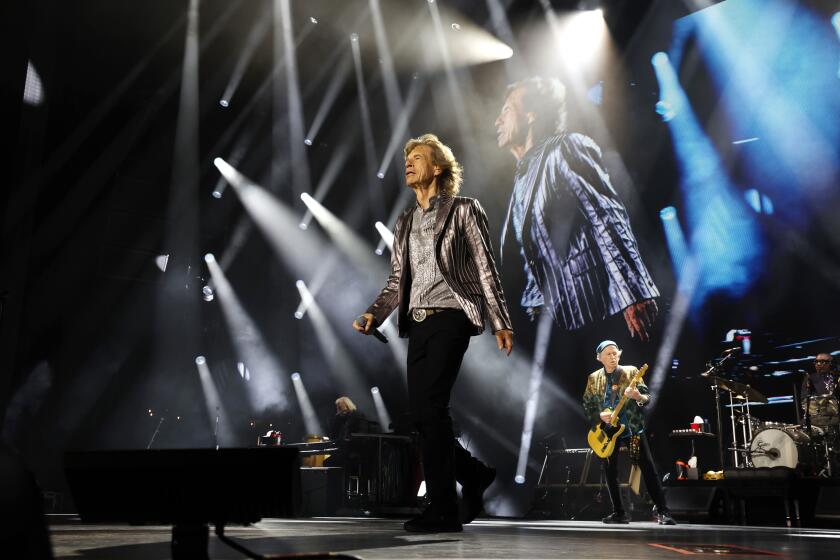A back-breaker of an agenda
THE affable fellow washing dishes by hand at the sink is not somebody’s South American houseboy. He is the celebrated Gustavo Santaolalla, a Renaissance music man who’s currently sailing on a confluence of successes in music styles as diverse as cutting-edge Latin rock, sophisticated classical and, most recently, the haunting film score to “Brokeback Mountain,” which has earned him his first Oscar nomination.
The former Argentine hippie who now hopscotches the world’s most prestigious stages doesn’t just do his own dishes at La Casa, his cozy if cramped studio complex in Echo Park. He also does his own introductions. With no manager and no full-time publicist, Santaolalla makes unabashedly self-promotional pitches to the famous people he’s courting within the elite creative circles to which Oscar nominees are privy. Often, these are people who’ve never heard of this guy with the multisyllabic surname, though he virtually invented -- then defined and dominated -- the field of rock en espanol over three decades as bandleader, guitarist, songwriter and producer.
After kitchen duty on this busy morning, Santaolalla is probing the possibility of landing Depeche Mode’s David Gahan as a guest singer on the new album by Santaolalla’s esoteric electro-tango fusion band, Bajofondo Tango Club. He takes a call from the British singer’s manager, pacing in a sunny den off the kitchen and ticking off his packed calendar of upcoming projects like a verbal resume: concerts in London and New York for Osvaldo Golijov’s “Ayre,” the classical work that he produced last year for Deutsche Grammophon, a “wonderful record,” if he does say so himself. New Latin albums by Argentine rock band Semilla and Spanish Gypsy Antonio Carmona. Plus another film score, for “Babel,” the latest movie by Mexican director Alejandro Gonzalez Inarritu (“Amores Perros”), starring Cate Blanchett and Brad Pitt.
One career highlight Santaolalla doesn’t mention: the recent Golden Globe he won for “A Love That Will Never Grow Old,” an original song from “Brokeback” performed by Emmylou Harris and co-written by Bernie Taupin.
“Great,” says Santaolalla, getting a nibble of interest from Gahan’s representative. “That’ll be fantastic. I’ll send you a package with all sorts of goodies. Ah, I’d love to, man.”
He hangs up and winds his way down a spiral staircase leading to a basement-level office where two young workers handle the music maven’s snowballing business. He stands on a step overlooking the room and itemizes the “goodies” he wants mailed to Gahan -- a CD of Mexican music by the Kronos Quartet titled “Nuevo” that he produced, the “Brokeback” soundtrack, plus his music from two other films: “The Motorcycle Diaries,” the Che Guevara road saga, and “21 Grams,” the second in Gonzalez Inarritu’s gritty urban trilogy.
Santaolalla finally sits still for the first time this morning. Looking relaxed in an exercise outfit despite multiple looming deadlines, he reflects on how it feels to be hawking himself like a novice. It’s as if he were still the anonymous immigrant who arrived in Los Angeles 28 years ago with a guitar on his shoulder.
“I can’t take for granted that people know who I am,” he says. “Do you think most people knew who I was when I got on stage for the Golden Globes? They didn’t have the slightest idea.”
But he takes no offense.
The media like to hang monikers on the well-known, he observes, and he’s had his share to shake. Time magazine has called him “The New Impresario,” one of the country’s 25 most influential Hispanics; he has his own label, Surco, distributed by Universal, and his own music publishing company. In Latin America, he’s been dubbed the King Midas of Spanish rock for his work with the genre’s most respected stars, including Colombia’s Juanes and Mexico’s Cafe Tacuba. And back home, he’s now called the Golden Argentine, a native son who publishes art books through a company named Retina and plans to make Malbec wines, a local variety, under a brand named for his son, Don Juan Nahuel, on a northern Argentina vineyard named for his daughter, Luna.
As long as he keeps moving, Santaolalla figures, the labels can’t stick.
“We are all dynamic,” he says, sitting across from a mosaic of 63 CD covers representing a portion of a career output that’s now approaching 100. “We have our contradictions and we go through life sort of correcting our course, always mutating. But once they turn you into a personality, you become a cartoon and you lose all those nuances that come with being a person.”
Santaolalla, 54, is fond of saying that he must have an agent in heaven because opportunities just keep falling in his path. In a career that started with teenage stardom in Buenos Aires, every move now seems to be a steppingstone on his road to Hollywood fame.
And to think that he credits it all to his love for a small South American guitar with the trilled name of ronroco.
The seed for the “Brokeback” score was planted at Sundance two years ago. At a party after the world debut of “Motorcycle Diaries,” film music supervisor Kathy Nelson suggested that Santaolalla meet director Ang Lee, who was working on an unusual new western.
“It was kind of a wild shot,” Santaolalla recalls. “Here you had a western being made by a Chinese director, shot by a Mexican cinematographer [Rodrigo Prieto] and then to say, ‘Well, now we should get an Argentine to do the music.’ ... You’d think at least they’d get a T-Bone Burnett or a Ry Cooder, someone like that.”
The meeting took place unexpectedly last year when Santaolalla was summoned to the Manhattan offices of Focus Pictures. Santaolalla showed up with his ronroco in a case.
“What is that?” Lee asked.
Anxious as an aspiring actor at a big audition, Santaolalla started to play.
The soft-spoken director recalls the encounter as a passionate “serenade.”
As the two men talked, they discovered they shared a similar musical vision for the film. Having read the script, Santaolalla had imagined open landscapes, the spare sound of two guitars, and most important, a silence pregnant with unspoken feelings.
“As it is, silence is something that I love in music, and here I could stretch that even more,” Santaolalla says, standing in front of his studio console with sound waves represented in peaks and valleys on computer screens. “In other words, the space you are defining between two notes ... Tingggggggg ... Dannnnnn ... That is not dead space. That is active space.”
He wanted those distinct notes -- which have gained instant pop culture recognition as “Brokeback” rides a wave of critical and commercial success heading into next Sunday’s Oscars -- to convey a sense of Americana. That, and a hint of dissonance to suggest an undercurrent of conflict.
“The notes are laconic,” Lee says. “They are lucid, yearning, and most of all elegiac. That’s something you cannot talk about, only feel. Like the mythical West is dead. And he really captured that.”
Within two weeks of his meeting, Santaolalla says, he had written 10 pieces for the movie, a collection of free-floating themes and soundscapes. He sent a tape of the new material to Lee.
“It was very funny, because Ang thought I had sent him samples of music I had done for other projects,” the artist recalls. “So he says, ‘What a shame, because this music would be perfect for my movie!’ ”
As it turns out, that was essentially the music used in the movie, after some editing and rewriting.
Explains Lee: “Usually you meet the composer to talk about music after the first cut, then the actual work comes on the second cut. With Gustavo, what’s really unique, the music is basically done beforehand. So I was hearing it as I was doing location scouting, so I kind of built the movie on those pieces of music.”
*
An early start
AT 13, Santaolalla obtained his first charango, a small and bright Andean guitar with a body made from the shell of an armadillo, and soon became an assiduous student of the instrument. He spent years recording various instrumental numbers on that guitar and its cousin, the ronroco.
That was the same year he first heard the Beatles. It marked the birth of his life’s mission to fuse two cultures.
Santaolalla’s first film score came about two years later. A man in his hometown of Ciudad Jardin asked him to put music to a short film about statues that come alive at night and roam around. “Las Estatuas” features him on drums making “weird little sounds” with brushes and cymbals.
He first gained fame in the early 1970s as founder, singer, songwriter and guitarist with a group called Arco Iris (Rainbow) which mixed rock with strains of Latin American folk music. That became the formula for the best of rock en espanol, which was to follow. But it also became the excuse for the military government of Argentina to crack down on Santaolalla, who looked something like a Rasputin of the Pampas with his bushy beard and unruly hair.
The musician says he was jailed several times for allegedly subverting homeland values with his hippie ways and imported rock ‘n’ roll rebellion. His music was banned from the airwaves.
“You cut your hair and became one of them or you left the country,” he says.
In 1978, Santaolalla fled to Los Angeles, where he embraced the punk and new wave movement and started a band called Wet Picnic along with Anibal Kerpel, another Argentine expatriate who has remained his partner and co-producer for almost three decades.
Almost two decades would pass before those accumulated charango instrumentals would come together as an album, reissued by Nonesuch in 1998 with the title “Ronroco.”
And in that collection, with its spare arrangements and moody soundscapes, was a song that opened the keys to Hollywood. Director Michael Mann wanted to use one of those tracks, “Iguazu,” for his 1999 film “The Insider,” a story about a tobacco industry whistle-blower starring Russell Crowe. Santaolalla said he couldn’t fathom how his gauzy, traditional music would fit a contemporary thriller. “But it worked,” he recalls. “Incredible!”
Santaolalla went on to score “Amores Perros,” a film nobody imagined would become a cinematic milestone. It led director Gonzalez Inarritu to tap him for the score for “21 Grams,” and it was Gonzalez Inarritu who later introduced him to Walter Salles, director of “The Motorcycle Diaries.” “It’s a chain, you understand,” Santaolalla says of his career climb. His recent film work also includes last year’s “North Country,” a sexual- harassment drama starring Oscar-nominated Charlize Theron.
One of Santaolalla’s assistants suddenly interrupts with an announcement: “I have Miles Copeland on the line.” He takes the call and makes another pitch to the record industry legend, whom he was courting as a potential manager for Bajofondo.
“I’m excited,” the musician says into the phone, “because I know you are into the fusion and mixtures of cultures and all that, and I think this is today.... So let’s talk some more and get to know each other and I’ll probably bring some more cool stuff for you. OK? Take care, man.”
A manager? Is Santaolalla going Hollywood on the eve of the Academy Awards telecast? What’s next? Moving to Beverly Hills and changing his name to Gus Santos?
Not on your life, says the artist, who often expresses pride in his Latino roots. That means his introductions in an Anglo world will forever pose a challenge -- especially for the celebrity who may be called on to say, “And the Oscar goes to....”
“I’m going to work hard to get people to learn to say my name right,” laughs San-ta-oh-lah-yah.
More to Read
The biggest entertainment stories
Get our big stories about Hollywood, film, television, music, arts, culture and more right in your inbox as soon as they publish.
You may occasionally receive promotional content from the Los Angeles Times.






